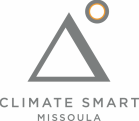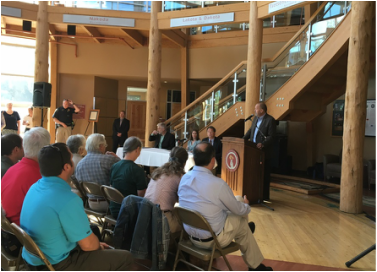 Yesterday, Governor Steve Bullock was on hand at the Payne Native American Center on the UM campus to promote his new plan for Montana’s electrical power sector. Missoula Mayor John Engen, Montana Renewable Energy Association (MREA) executive director Diana Maneta, and Missoula Federal Credit Union (MFCU) CEO Jack Lawson shared the stage with the Governor for a rather quick (but engaging!) conversation about clean energy in our state, sponsored by Charge Montana. Climate Smart was there and here’s what caught our attention. We welcome your thoughts. First, the Governor highlighted key goals contained in this energy “blueprint” that he hopes to achieve by 2025, including:
And it’s encouraging that the Governor’s vision includes capitalizing on Montana’s abundant clean energy resources – especially solar. We know energy is an important sector of our state economy, and as MREA’s Maneta reminded us, it is a sector in transition. Already, nearby states who buy our energy are moving away from coal and towards renewables like wind and solar power. As the price of solar continues to drop, doubling solar investment is a no-brainer. In fact, we think we could beat that goal handily: solar currently makes up a mere 0.1% of total electricity generation in Montana, even though it has the potential to meet 28% of our electricity need. Let the sun shine! An important piece of this puzzle is, of course, funding. MFCU has been a key partner in the Solarize Missoula campaign, and they are eager to find more creative ways to support renewable energy. As Lawson explained, there are three great reasons for MFCU to partner on clean energy: it aligns with their mission of building members’ financial stability, it reflects their members’ desire for their dollars to have a positive social impact, and dropping costs mean it’s also just good business! Done right, renewable energy benefits everyone. Just look at the solar industry, which is growing by leaps and bounds. That’s especially good news for jobs. Nationwide, over 200,000 people are employed in the solar industry – nearly triple the number in coal – and that number is expected to double by 2020. In 2015, the solar industry added jobs 12 times faster than the rest of the economy. We’re excited to hear the Governor’s support for harnessing the potential of solar to provide good jobs and build a more resilient energy economy, able to meet the challenges of a changing climate. We liked what Mayor Engen said: the Governor’s plan represents an opportunity to “determine our future instead of stumbling into it.” We’re thrilled so many community leaders and members came out mid-morning and mid-week to engage in this mid-transition energy discussion. Missoula is right in the middle of the solutions – a great place to be. What do you think?
0 Comments
I had a special relationship with the giant sycamore tree in my front yard growing up. I would climb into the upper branches, reveling in how different everything on the ground looked from my perch high in the air. Or I’d spend hours in the nearly perfect seat formed where the main trunk split into two, reading a book or studying the spotted bark and pointed leaves. Do you have a similar story? As we get older, we don't often stop to think about the trees that populate our neighborhoods, parks and open spaces. We all know trees are important. They beautify our city, they keep us cool, they give us clean air to breathe. How can we keep our trees happy and healthy? On June 2nd, Climate Smart Missoula’s monthly meetup was all about trees. We were joined by Karen Sippy from the citizen advocacy group Trees for Missoula, Chris Carlson from the City of Missoula Parks and Recreation Dept, Juliet Slutzger from the National Wildlife Federation, and curious community members. Here’s what we learned:
Wondering what you can do to help keep our urban forest in tip top shape?
As we experience hotter, drier summers, caring for our trees and growing more shade will be increasingly important. Check out our Summer Smart program and our Urban and Wildland Forests bucket to learn more! On May 5th, Missoula community members gathered to learn and talk about local food and agriculture and climate change. Kim Gilchrist with the Community Food and Agriculture Coalition (CFAC) started us off with an overview of the food system, tracing the steps that get our food from farm to fork. She described the work that CFAC is doing to support farmers and farmland and improve access to local food for all members of our community, including the Double Snap Dollars program. Greg Price of Garden City Harvest described the climate change impacts he’s observed in his 15 years of experience as the manager of River Road Neighborhood Farm. Greg explained that climate change has brought tradeoffs between a longer growing season on one hand, and more extreme heat and less water for irrigation on the other. Caroline Stephens, produce manager at Foothill Farm, also shared about her graduate research interviewing Montana farmers about drought and climate change.
Missoula is known for its vibrant local food scene, with farmers’ markets buzzing on Saturday mornings, restaurants featuring local produce, and thriving community gardens. For many Missoulians, our local food culture is part of what makes Missoula a great place to live. But the abundance and diversity of local food and sustainable agriculture also increases our community’s resilience to climate change. When we produce more of our food nearby, we are less dependent on global and national supply chains that are vulnerable to climate impacts, and we strengthen our local economy. Food hubs, such as the Western Montana Growers’ Co-op, aggregate produce from many farms and distribute it to grocery stores and institutions like schools and hospitals, and help connect small farmers with more diverse markets. And when local sustainable agriculture is combined with efforts to reduce food waste, we shrink the carbon footprint of our entire food system, making our community healthier and more sustainable in the long run. Interested in learning more about how Climate Smart Missoula and community partners are working on this issue? Check out our Local Food and Agriculture bucket. |
AuthorsAbby Huseth Archives
July 2024
Categories
All
|
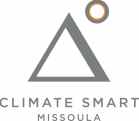
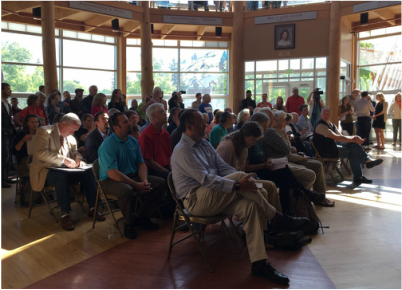
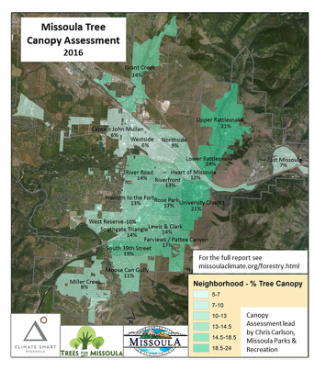
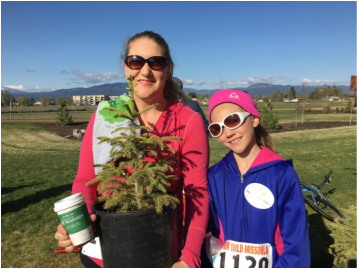
 RSS Feed
RSS Feed


